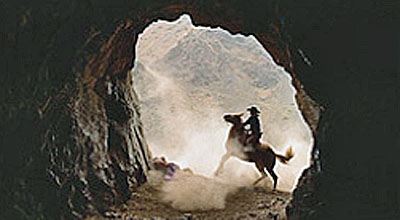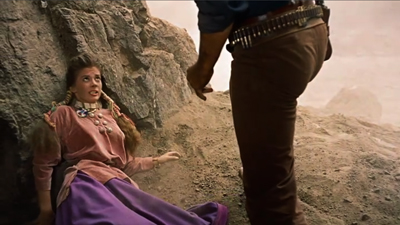When I discovered a book review last week about “The Searchers: The Making of An American Legend” by Glenn Frankel, I was already ordering it before I read whether the reviewer thought it was good or not.
My motivation wasn’t just my unconditional adoration of John Ford’s 1956 masterpiece, starring John Wayne. It was also because I was hoping for an answer or at least insight into Ford’s decision as to why he filmed the climactic scene where Wayne’s Ethan Edwards finally catches up to Natalie Wood’s Debbie at Bronson Canyon here in Hollywood.
 In the film Debbie flees across the barren plains of Monument Valley with Ethan in hot pursuit on horseback. But instead of reuniting them there, Ford quick-cuts to Debbie running up to the mouth of the Bronson Canyon cave/tunnel. Wayne comes charging down the adjacent slope, dismounts and approaches his long-lost niece, undecided still as to whether he’s going to save her because she’s kin or let his hatred of Indians take over and kill her because she’s long assimilated into the native culture she was abducted into as a child.
In the film Debbie flees across the barren plains of Monument Valley with Ethan in hot pursuit on horseback. But instead of reuniting them there, Ford quick-cuts to Debbie running up to the mouth of the Bronson Canyon cave/tunnel. Wayne comes charging down the adjacent slope, dismounts and approaches his long-lost niece, undecided still as to whether he’s going to save her because she’s kin or let his hatred of Indians take over and kill her because she’s long assimilated into the native culture she was abducted into as a child.
As a local who’s haunted them thar Hollywood Hills since I was a kid, I’ve known about Bronson Canyon since I was in elementary school, and I can remember watching “The Searchers” for the umpteenth time about 10 years ago and finally recognizing it. And yes, during visits since, I’ve gone to the mouth of that cave entrance in full-on fanboy awe knowing that I was standing in the exact spots where The Duke and Ford themselves had stood. One time, while overhearing a trio of visitors talking about the place’s use in lesser vehicles such as “Batman” (the ’60s TV series), “Star Trek VI,” and “Army of Darkness.,” I shared what I knew with them. Sadly, my enthusiastic description of the scene (complete with where Ford set up the camera) was lost because none of the three had seen the classic (which I feel should be a crime against entertainment).
I hold the film dearer to my heart knowing part of it was filmed in what is basically the playground of my past and so readily accessible at present. But with so much of the film’s exteriors shot in and around the organic magnificence of Monument Valley (itself a star of the film), I’ve long wondered what happened to bring Ford and Wayne and Wood to film that pivotal scene back here in Hollywood at what is in essence so fake a location entirely incongruous to the established wide-open scope of the West’s great outdoors. As such, I couldn’t resist diving into the back of the book to see if it was there. Thanks to Frankel, I now have the answer and so much more.
From the book:
Four days later, Ford took John Wayne, Natalie Wood, and a camera crew to Bronson Canyon to shoot the film’s climactic scene in which Ethan finally hunts down Debbie. The canyon was one of Hollywood’s classic outdoor locations, a former quarry carved into the southwest corner of Griffith Park just a few miles east of the Culver City studio. Brown and barren, it readily stood in for the rocky terrain of the West. From “Riders of the Purple Sage” (1925) to “I Am a Fugitive from a Chain Gang” (1932) to “Zorro Rides Again” (1937), anyone who needed a cheap natural location within a bus ride from a studio had resorted to Bronson Canyon over the years. Ford didn’t go there save money, however, but to solve a problem. As usual, he left no notes to explain. But it’s likely Ford and his crew had filmed the climactic scene in Monument Valley in July according to the [Frank] Nugent screenplay and that Ford had decided at the last minute to change it.
Nugent’s original script spells out exactly what is supposed to happen and why:
Ethan Dismounts with his gun drawn, pointing it at Debbie. “I’m sorry, girl,” he tells her. “Shut your eyes.”
The camera holds on Debbie’s face — the eyes gaze fearlessly, innocently into Ethan’. After a moment, he lowers his gun and puts it away. “You sure do favor your moth,” he tells her. Then he extends his hand, puts his arm protectively around her and a reconciled uncle and niece head for home.
 Somewhere between the original filming of the scene and August 12, Ford decided to reach for a different ending. He clearly wanted something more visual and ambiguous — something the audience could see and feel and not have explained to them. “I wonder, did they box themselves into a corner and find themselves having to shoot this at the very end?” asked Ford scholar James D’Arc. “Bronson Canyon’s the obvious quickie solution.”
Somewhere between the original filming of the scene and August 12, Ford decided to reach for a different ending. He clearly wanted something more visual and ambiguous — something the audience could see and feel and not have explained to them. “I wonder, did they box themselves into a corner and find themselves having to shoot this at the very end?” asked Ford scholar James D’Arc. “Bronson Canyon’s the obvious quickie solution.”
As he did so many times, Ford threw away Nugent’s dialogue and improvised. The face that he would be jump-cutting from the flat parched floor of Monument Valley to the hilly rock-strewn path leading to Bronson Canyon did not seem to trouble him. In the filmed version, Ethan chases Debbie down, calling out her name — similar to the way he had called out Martha’s name earlier in the film when he searched for her among the flaming ruins of the ranch house. Desperate to escape him, Debbie reaches the mouth of the cave and then collapses. Ethan dismounts, stands over her, then lifts her over his head in one sweeping motion and takers her in his amrs. “Let’s go home, Debbie,” is all he says.
For Ford and his crew, it was a quick visit. They started shooting at Bronson Canyon at 11:00 that morning and finished up at 12:45. They broke a half hour for lunch and then headed back to the studio.
Damn. I’ve long been a searcher for that information. I can’t wait to start at the beginning of Frankel’s book and see what else he has to show me about one of the greatest motion pictures ever made.
 Follow
Follow